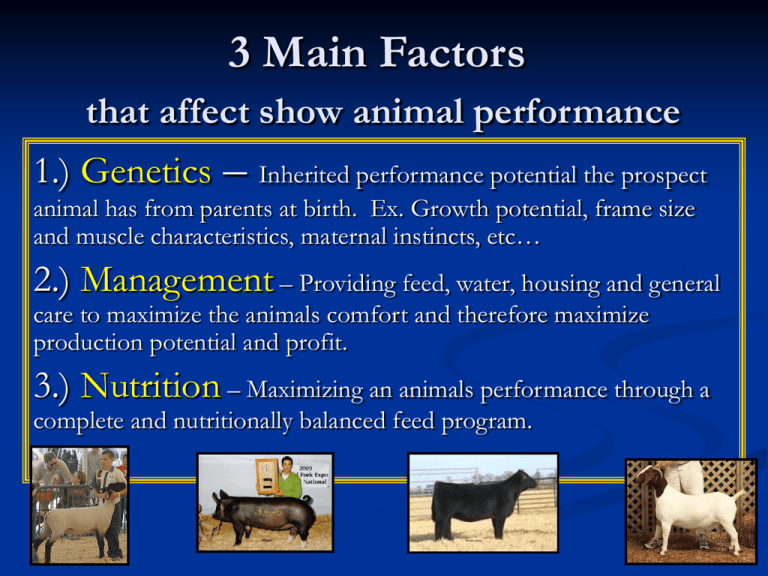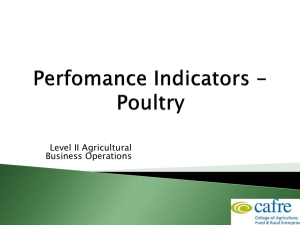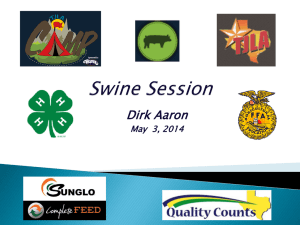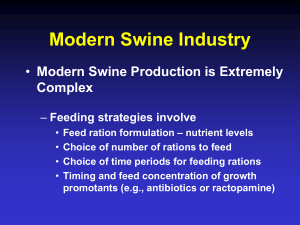
3 Main Factors
that affect show animal performance
1.) Genetics
– Inherited performance potential the prospect
animal has from parents at birth. Ex. Growth potential, frame size
and muscle characteristics, maternal instincts, etc…
2.) Management – Providing feed, water, housing and general
care to maximize the animals comfort and therefore maximize
production potential and profit.
3.) Nutrition – Maximizing an animals performance through a
complete and nutritionally balanced feed program.
Nutrition Management for Show
Cattle and Swine
Market trends change through out time….
1950’s
2009
But the basic nutritional requirements of all livestock have not.
Nutrition
6 Nutrient Classes essential for proper body function-
1. ProteinMade up of Amino Acids, building blocks of complex proteins.
Build Structure (frame and muscle), repair and regulation:
Body frame and structure
Soybean meal, cottonseed meal, fish meal, corn gluten meal, whey
products, animal protein products, plant protein products, etc…
Nutrition
6 Nutrient Classes essential for proper body function-
2. Carbohydrates –
Primary function to provide energy, contribute small
amounts to protein and other nutrients.
Fuel for the body and some structure
Corn, barley, oats, milo, grain by-products, forage
products, etc…
Nutrition
6 Nutrient Classes essential for proper body function-
3. Lipids (fats)–
Only function to provide energy, fatty acids aid in skin
condition, hair coat – 95% fat, allows for economically
increase the energy density of a feed without feeding more
bulk .
Fuel for the body
liquid vegetable oils, dried fats, animal tallow, etc…
Nutrition
6 Nutrient Classes essential for proper body function-
4. and 5. Vitamins and Minerals
Vitamins- Regulation of bodily function: Vitamin A, D, E, K, C, B-Vitamins
(Thiamine, riboflavin, B12, etc…)
Minerals- Building Stucture (skeletal), body repair, function and regulation:
(Calcium, Phosphorus, Sodium, Potassium, Zinc, Copper, Manganese,
Iron, Selenium, Iodine, etc…)
Structural and Regulatory Support
Nutrition
6 Nutrient Classes essential for proper body function-
6. Water MOST IMPORTANT nutrient, and most forgotten. Involved in the regulation of all
bodily functions. Makes up largest single component of body – average 60% in
large livestock.
Effects feed intake, ability to fight stress, illness and disease.
Never with-hold water for more than very short periods of time with the
exception of under a veterinarians instruction and supervision.
Complete and Balanced
How to Pick a Feed
Species-Cattle, Dairy, Swine, Sheep, Goat, Horse, Poultry,
Rabbit. For show animals, general grain mixes or mixed species feeds may
be cheaper, but are not specific in nutrients (especially vitamins and minerals) for optimum
growth and production.
Type of digestive system:
* Ruminant: Beef and Dairy Cattle, Sheep, Goats. They have 4 chambers in digestive tract
(rumen, reticulum, omasum and abomasum). Primary feed is vegetative, plants. High fiber with
large capacity.
* Non-ruminant (Simple stomach): Swine, dogs, fish, and humans.
Have one
* Non-ruminant Herbivore: Horses, rabbits, guinea pig, hamster:
Have
stomach. Limited capacity.
limited capacity, but primary feed is vegetative, plants. Grazing
Feeding Show Steers and Heifers
Purpose
of Feed: What is the desired end result?
*Starter - For young animals under 300 pounds-
18% crude protein, 3.0 – 3.5% crude fat
Feeding steer and heifers calves at this stage the same.
High in protein, energy and vitamins and minerals to support
optimum structural and muscular growth.
Promote a good start,
And it will carry on into later life
Feeding Show Steers and Heifers
Grower – For animals between 300 to 900# depending upon breed, sex and desired finished weight.
*
At this phase, begin feeding steers and heifers differently.
Steers:
Moderate protein and energy with a high vitamin and mineral balance to still support optimum
structural and muscular growth.
15 to 16% crude protein, 3 – 3.5% crude fat
----------------------------------Feeding Rate: Steers will be eat between 2.5 to 3% body weight per day,
Divided into 40% concentrate (grain mix)
60% roughage (hay)
For Example: a 600# steer will eat between 15 to 18# total feed per head per day.
17# x 60% = 10# roughage, hay
17# x 40% = 7# grain mix
Feed at least 2 times per day.
Provide free choice access to a clean, fresh water supply and salt at all times.
Feeding Show Steers and Heifers
Heifers:
Moderate protein and reduced energy. A high vitamin and mineral balance to still support
optimum structural and reproductive growth.
15 to 16% crude protein, 2.0 -2.5% crude fat
Too high a fat level for heifers will cause them to finish out too soon,
put on too much weight that will interfere with reproduction and may negatively
influence development of milk production systems. Feed to breeding weight.
----------------------------Feeding Rate: Heifers will be eat between 2.5 to 3% body weight per day,
Divided into 40% concentrate (grain mix)
60% roughage (hay)
For Example: a 600# heifer will eat between 15 to 18# total feed per head per day.
17# x 60% = 10# roughage, hay
17# x 40% = 7# grain mix
Feed at least 2 times per day.
Provide free-choice access to a loose or block form of vitamin and mineral supplement – not tm salt.
Provide free choice access to a clean, fresh water supply and salt at all times.
Feeding Show Steers
*Finisher- For final phase of cattle growth. Protein requirements are lower, but energy requirements increase
for marbling and finish conditioning (fattening). Vitamins and minerals are still required but in lower amounts
to maintain proper bodily function, such as immune system.
12-13% crude protein, 4 to 5% crude fat.
-----------------------------------
Feeding Rate: Steers will still be eating between 2.5 to 3% body weight per day, BUT, now
Divided into 60% concentrate (grain mix)
40% roughage (hay)
For Example: a 900# steer will eat approximately 27# total feed per head per day.
17# x 40% = 11# roughage, hay
17# x 60% = 16# grain mix
Feed at least 2 times per day.
Provide free choice access to a clean, fresh water supply and salt at all times.
Watch carefully at this stage. When your feeding 25 to 30 # per day, watch for scours, feed
refusal, any change in regular behavior. These signs could indicate serious digestive upset and need to
addressed quickly.
Keep sodium bicarbonate (baking soda) on hand for acidosis and Thera-Bloat for bloat control.
Feeding Show Swine
*Starter -
For young animals under 40 pounds20% to 23% crude protein, 3.5 – 4.5% crude fat
High in protein, lysine and methionine, energy and vitamins and minerals to support
optimum structural and muscular growth.
A combination of protein sources such as soybean meal, blood or plasma, and whey
make for a better amino acid profile.
Lysine and methionine are the most important amino acids to growing swine.
-----------------------------------------
Feeding rate: Feed free choice during this period. Provide free-choice access to a
clean, fresh water supply at all times.
Promote a good start,
And it will carry on into later life
Feeding Show Swine
*Grower/Finisher - For hogs from 40 pounds to market weight16% to 20% crude protein, 4.5 – 6.0% crude fat
High quality protein, lysine and methionine, energy and vitamins and minerals to continue optimum structural
and muscular growth.
Lysine and methionine are still limiting amino acids and are required for muscle development.
------------------------
Feeding directions: Feed free-choice to 160 pounds, then…
Evaluate for average daily gain and body condition.
If on track, continue with same feed, hand feed at 3 – 4% of body weight per day in 2 equal feedings.
example: For a 180 pound pig, feed 6 pounds (3.5%)
OR
If needing to push for extra weight or need a “softer” carcass, hand feed at 4% of body weight per day
and add a weight gain supplement such as liquid fat (golden energizer), Calf Manna, Sumo as label
recommended. You may need to feed 3X per day, make any changes gradually over a 5 – 7 day period.
OR
If needing to slow down growth and hold, reduce the amount of complete feed by ¼ to ½ and replace
with beet pulp, Full Tank, Bloom and Fiber, etc. If using beet pulp shreds, best to soak before feeding.
Slows down daily gain and growth
Maintains happier pigs due to feeling full, not hungry, easier to work with.
Important: Provide free-choice access to a clean, fresh water supply at all times.
Limiting access to water during weigh-in and on show day is a common practice and should be exercised
carefully. Dehydration will be made worse by stress, and can be dangerous.
Feeding Show Steers, Heifers
and Swine
*Supplements- Feed additives top dressed or mixed into primary feed
to produce a more specific result.
- Vegetable Oil – added to increase energy (fat) density of primary feed.
- Prebiotics and Probiotics – addition of microbial products to
strengthen digestive health and balance during times of stress.
Probios, Manna E, BioMos, Acidifiers
- Other additives – Calf Manna, Beet Pulp, Rolled Oat Groat, Sumo,
Full Tank, MEDICATIONS, etc….
All of these feeds have specific purposes.
Using a product by mistake or inappropriately
can not only be expensive, it can prevent a successful
project.
Call your feed store or contact the manufacturer for any questions.
Medications
Medications are added to feed for specific reasons. Do not assume that if it works
in one species, it automatically would work in another.
For example: asprin in dogs vs. cats
Do not misuse or abuse any medications.
* Do not use in unapproved species. Not only is this unlawful, but it is
unethical and may be causing undo harm to an animal and you won’t
know it.
* Always follow label instruction for proper use. Off label use is
against the law. Don’t forget that you are raising “food”!
* Do not over-dose. “Well, it this much works this good, more should work
even better.” Not necessarily, some medications when over-dosed
become harmful, even lethal.
* Always check expiration dates on medications. Some expired drugs get
weaker the older they get, but some get stronger and even lethal . Even
check the dates when your at the feed store.
* ALWAYS, ALWAYS, ALWAYS pay attention to warning about personal
safety when using a product.
* Special warnings about Paylean.
Management
Figuring (ADG) Average Daily Gain needed to make
fair weight.
1. Get accurate start weight of animal. Example 40# piglett
2. Determine finished weight desired at fair time. Example 230# pig
3. Check calendar and determine how many days until fair check in.
Example: 4 months and 8 days = 128 days total
Calculation:
Part 1:
2 parts
Finish weight – Start weight = Total weight needed to gain
(230#)
(40#)
= 190 pounds needed to gain
then
Part 2: Pounds needed to gain ÷ Number of day until fair check in = Average
190#
÷
128 days
= 1.48 # ADG
Daily Gain (ADG)
Meaning: Your pig needs to gain at a minimum 1.48# a day until fair to hit the target weight of 230#.
Do this exercise regularly!!! 2 – 3 x per month is not too often with animals that may be smaller, slower
growers or fast growers and easy keepers. This will help determine how well your animal is growing and
will prevent any surprises at the check-in scales. It is easier to hold or slow down versus pushing hard.
Estimating weight – without a scale
Dana Moore-Young
The Greeley Elevator Company
(970) 352-2575
dyoung.greeleyelevator@gmail.com







